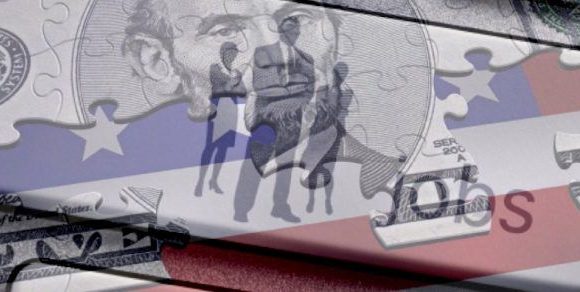U.S. economy slows to fragile 0.5%, weakest growth in two years
by April 28, 2016 11:30 am 306 views

U.S. business growth decelerated for the third straight quarter in the first three months of 2016 as the current outlook for a broad economic expansion is now in question as the nation’s economy slows to its weakest level in two years.
Real gross domestic product – the value of the goods and services produced by the nation’s economy less the value of the goods and services used up in production, adjusted for price changes – increased at a weak of 0.5% in the fourth quarter of 2015, according to the “advance” estimate released by the Bureau of Economic Analysis today (April 28).
The advance first quarter GDP estimate, which is the first of three estimates by the Department of Commerce’s BEA research group, also came in one percentage points below the latest GDPNow model forecast of 0.6% by the Atlanta Federal Reserve on Thursday. Also, economists surveyed by The Wall Street Journal had expected GDP to grow at a 0.7% pace.
Since the second quarter of 2015, when real U.S. GDP accelerated at a robust 3.9%, the U.S. economy has slowed considerably to 2% in the third quarter and to a tepid 1.4% in the fourth quarter.
News of the third straight quarter of declining U.S. growth supports the Federal Reserve’s decision on Wednesday to hold the target range for the federal funds rate to 0.25% to 0.5%.
In a statement following the end of the Federal Open Market Committee’s two-day meeting, the fiscal panel said although labor market conditions have improved since the last FOMC meeting in March, economic activity in the U.S. appears to have slowed.
“The federal funds rate is likely to remain, for some time, below levels that are expected to prevail in the longer run,” the FOMC committee said. “However, the actual path of the federal funds rate will depend on the economic outlook as informed by incoming data.”
U.S. CEOs ‘GUARDED’ ABOUT ECONOMY
The first glance at U.S. growth in the 2016 also confirms concerns expressed by a panel of chief executives surveyed by The Conference Board last week.
“CEO Confidence improved in early 2016, but sentiment about the economy remains somewhat guarded,” said Lynn Franco, Director of Economic Indicators at The Conference Board.
Still, CEOs’ appraisal of economic conditions has improved, with about 19% saying conditions are better compared to six months ago, up from 14% last quarter. Likewise, business leaders’ assessment of conditions in their own industries was also more positive, with 18% claiming conditions in their own industries have improved, versus just 11% in the previous quarter.
CEOs are less pessimistic regarding the short-term outlook, with 18% expecting economic conditions will improve over the next six months, up from 16% last quarter. The outlook for their own industries was also better, with 22% anticipating an improvement in the next six months, versus approximately 19% in the fourth quarter.
Following are other highlights of the first quarter advance GDP report.
• Real gross domestic purchases – consumption by U.S. residents of goods and services wherever produced – increased 0.9% in the first quarter, compared with an increase of 1.5% in the fourth quarter of 2015.
• The price index for gross domestic purchases, which measures prices paid by U.S. residents, increased 0.3% in the first quarter, compared with an increase of 0.4% in the fourth. Excluding food and energy prices, the price index for gross domestic purchases increased 1.4%, compared with an increase of one percent.
• Current-dollar GDP – the market value of the goods and services produced by the nation’s economy less the value of the goods and services used up in production – increased 1.2%, or $56.3 billion, in the first quarter to a level of $18.2 trillion. In the fourth quarter, current-dollar GDP increased 2.3%, or $104.6 billion.
• Current-dollar personal income increased $130.8 billion in the first quarter, compared with an increase of $117.4 billion in the fourth. The acceleration in personal income primarily reflected an upturn in personal interest income and a rise in wages and salaries and in farm proprietors’ income.
• Personal current taxes increased $24.3 billion in the first quarter, compared with an increase of $28.4 billion in the previous quarter.
• Disposable personal income grew to $106.5 billion, or 3.2%, in the first quarter, compared with an increase of $89 billion, or 2.7%, in the fourth. Real disposable personal income increased 2.9%, compared with an increase of 2.3%.
• Personal outlays increased $72.5 billion in the first quarter of 2016, compared with an increase of $90.9 billion in the third. Personal saving – disposable personal income less personal outlays – was $712.3 billion in the first quarter, compared with $678.3 billion in the prior three-month period.
• The personal saving rate – personal saving as a percentage of disposable personal income – was 5.2% in the first quarter, compared with 5% in the fourth quarter.
According to the BEA, “advance” estimates, based on source data that are incomplete or subject to further revision by the BEA, are released near the end of the first month following the end of the quarter. As more detailed and more comprehensive data becomes available, “second” and “third” estimates are released near the end of the second and third months, respectively.
The revised second GDP estimate for the first quarter will be released on May 27. The final revision will include additional data on first quarter and yearly earnings on U.S. companies.
